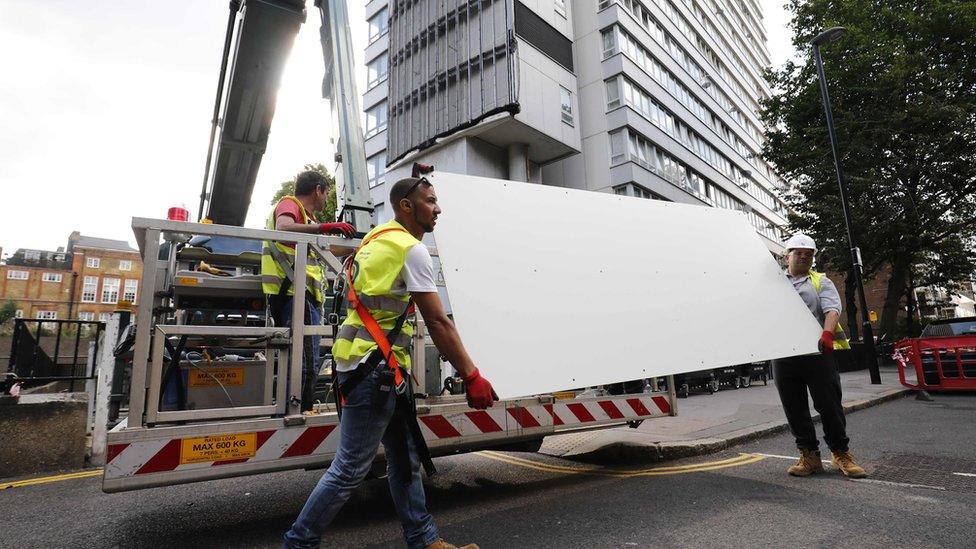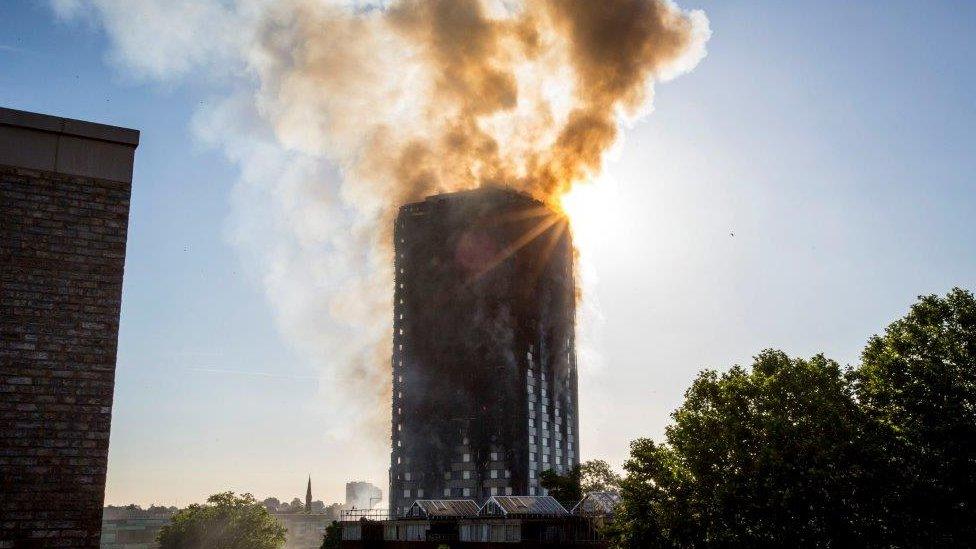Cladding type 'used for Grenfell' found in some Scottish schools
- Published

At least 80 people are believed to have died in the Grenfell Tower fire in London
A type of cladding said to have been used on Grenfell Tower has been found on a small number of low-rise schools in 14 Scottish council areas.
Checks are currently being carried out to ensure that the type of aluminium composite material has been fitted in accordance with building regulations.
No Scottish local authority-owned school buildings above 18 metres have ACM cladding.
The findings emerged during a meeting of a Ministerial Working Group.
It was convened to examine building and fire safety regulatory frameworks following the Grenfell Tower fire in London last month in which at least 80 people are believed to have died. The group met for the third time on Thursday.
Under Scottish building regulations, the type of ACM reported to have been used on Grenfell should not be used in cladding on high-rise domestic properties, but can be used "appropriately" on other buildings.
In each case, the cladding systems must meet the relevant technical requirements.
The meeting heard that no high-rise domestic buildings owned by councils or housing associations in Scotland have used ACM cladding.
Thirty of Scotland's 32 local authorities have reported that ACM cladding has not been used on any privately owned high-rise domestic buildings.
Edinburgh and Glasgow are completing their investigations and it was acknowledged this will take time due to the numbers involved.
Aberdeen City Council confirmed that aluminium cladding with a polyethylene core had been used on extensions at two schools in the city - Woodlands School and Aberdeen Grammar.

Cladding from tower blocks across the UK has been tested in the wake of the Grenfell Tower fire
But it said the material was not the same as that used in Grenfell, and the work was "in full accordance with building regulations when they were constructed".
A spokesman said: As stated by the Scottish government, the materials have been used appropriately and following consultation with the relevant government departments and Scottish Fire and Rescue service we are satisfied at this time there is no risk posed by the materials used."
All Scottish health boards have confirmed that none of their buildings use the cladding type reported to have been used on Grenfell Tower.
However, additional checks have shown that eight sites on the NHS estate - including Queen Elizabeth University Hospital (QEUN) in Glasgow - have used solid aluminium with A1 non-combustible fire rating material and mineral wool insulation.
NHS Greater Glasgow and Clyde has, however, been assured by Multiplex, the main contractor for the hospital construction, that the insulation material used in QEUH - Kingspan Kooltherm K15 Insulation Boards - were properly installed to meet building and fire safety regulations.
The meeting was chaired by Communities Secretary Angela Constance with Housing Minister Kevin Stewart and they were joined by Scottish government officials and the Scottish Fire and Rescue Service.
'Reassure people'
Ms Constance said: "The group met today to continue our thorough review of our regulations and take any action needed - both immediate and longer-term - to ensure the highest standards of building and fire safety is in place across Scotland.
"While we continue to be confident that we have stringent building and fire safety regulations, we cannot afford to be in any way complacent. That is why our work programme is evidence-led and our focus is prioritised.
"Checks continue across Scotland by both local authorities and the fire brigade to assess buildings and reassure people that adequate fire protection measures are in place."
The Scottish government reiterated that building standards systems and regulations for high-rise domestic properties in Scotland means the type of product used on Grenfell Tower should not be used in their cladding systems.
However, in some controlled circumstances specified by Scottish building regulations, ACM can be used as part of the cladding systems of other buildings.
Scotland's building regulations specify that those cladding systems must meet the relevant technical requirements applicable in each case.
The group will meet again early next month when it will review evidence on automatic fire suppression systems including sprinklers.
- Published13 July 2017

- Published23 June 2017

- Published22 June 2017

- Published20 June 2017
